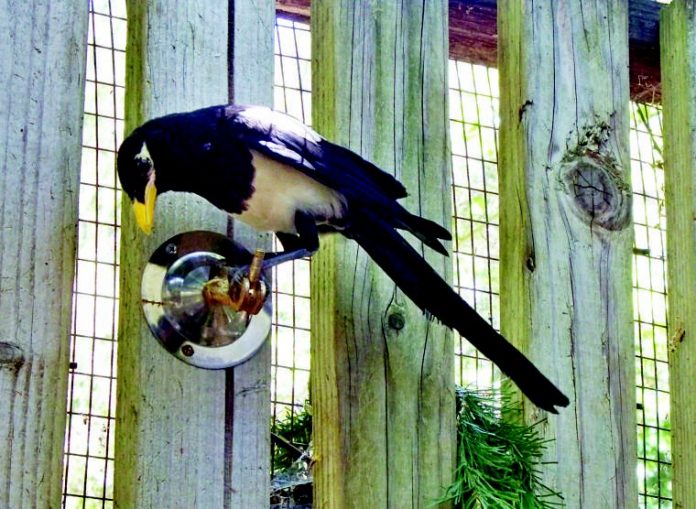
Do not feed the birds … hamburger, spaghetti, Cream of Wheat, filet mignon, mashed potatoes.
These are some of the foods that people have told us they fed to wild birds that they “rescued.” Spaghetti because it “looks like a worm;” Cream of Wheat because that’s what human babies eat; raw hamburger fed to orphaned owlets. Some people seem to think a human’s holiday dinner is fine for the birds, too – they’ve been fed chicken, mashed potatoes (because it was “soft food”), bread, milk (because the birds “needed calcium”) and vegetables.
It’s important to know not only the specific diets of each species, but also their feeding behavior and the dietary changes required as the bird matures.
This yellow-billed magpie is an example of the importance of bringing orphaned wild animals to a licensed wildlife rehabilitator. It was a fledgling when it was found last year in South County and the finders kept it for two weeks before bringing it to the Wildlife Education and Rehabilitation Center. It was weak when it arrived due to being fed an improper diet. It may have survived for as long as it did because magpies eat a wide range of foods, including insects, fruit, nuts and carrion. So whatever it was being fed originally must have been adequate, though not necessarily nutritious.
At WERC, it was immediately put on an appropriate diet, which included small rodents supplemented with vitamins. Within one month, it had recovered its health and its feather condition was fabulous. Because magpies form a communal society, it was released near the location where it had been found.
If I had my druthers, the yellow-billed magpie would be California’s state bird because it is the only species of bird that is restricted to our state, found nowhere else in the world. It is non-migratory and limited to central California. The 19-inch long bird has a glossy black, green iridescent head, wings, a long tail and sports bold white wing patches and white belly. It is similar to the more widespread black-billed magpie, which ranges from southern Alaska to most of central and western Canada and United States.
The yellow-billed magpie thrives in oak woodlands, open areas, grasslands, along streams, pastures, fields and orchards. The highly intelligent birds are sociable, gregarious and tolerant of humans. If you’re hosting out-of-state guests who love birding, take them for a rare treat to watch for local groups of the magpies – called a “tiding,” “charm,” “tittering” or “tribe” – and listen for their noisy kwah-kwah-kwah call. You’ll see the birds running, hopping and walking on the ground looking for grasshoppers, earthworms, fruit, acorns, eggs (which they steal from the nests of other birds), in addition to the aforementioned fruit, nuts and carrion. They store surplus food in tree hollows and holes that they’ve dug in ground.
Also look for their unusual homes: Yellow-billed magpies make a very large nest, shaped like a domed bowl, out of sticks and mud, and lined with hair, grass and bark. The nests are built high in trees, especially valley and coast live oaks, both of which are endemic to California.
In the 19th century, magpies were close to being killed off because they were erroneously thought to be a threat to crops and livestock. In recent years, habitat loss and the use of pesticides to kill ground squirrels has caused the yellow-billed magpie population to decline. Magpies are also extremely susceptible to the West Nile virus because they tend to roost near water, thus exposing them to mosquitoes. Between 2004 and 2006, it’s estimated that 50 percent of all yellow-billed magpies died of the virus.
You can help the populations of magpies and other wild birds flourish. If you find a wild animal that you believe is injured or orphaned, call your nearest licensed wildlife rehabilitator asap for advice. Don’t feed it on your own – it’s illegal to care for native wildlife without permits. The rehabilitator knows the proper diet and method of feeding each species.














